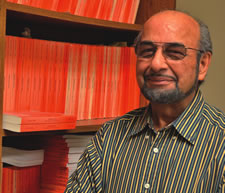Sustaining the Advancement of Multisensing Devices

Professor of engineering Amar Bhalla, Ph.D., sees the future of science in the tip of a human finger. Within that square inch or so of skin, Bhalla points out, a matrix of neurological sensors which detect pressure, texture, temperature, and pain. Accompanied by the mobility functions of the hands, such as abilities to flex, grip, and tense, the fingers and hands sense and manipulate the environment. Humans become adept at accomplishing functions such as grasping objects, using tools, writing words, playing musical instruments, and much more.
Bhalla, a distinguished research professor in UTSA’s Department of Electrical and Computer Engineering since 2007, directs an international program focused on discovering and developing the materials that will be the foundation for the next generation of technology. Bhalla affirms that multisensing devices, capable of doing more than one thing, are the future of medicine, industry and even consumer products.
“We humans are multifunctioning and multisensing beings,” said Bhalla. “This is the vision for our technology as well. We need to have each single device that can do many things,” Bhalla continued.
Bhalla, who came to UTSA six years ago, is developing a global network of scientists and inventors who share like visions and who work together on research and inventions, with the support of their governments.
“This is the science of a new era, and we are in a new era of science,” Bhalla says with a smile. “The new science is based on nanotechnology. The new era is learning, ‘How do we capture the benefits of science all around the world?’ ” he continued.
Bhalla is now three years into the program, called the International Network for Advanced and Multifunctional Materials (INAMM). It is supported by a grant from the National Science Foundation. UTSA is the lead institution, with Virginia Tech (Professor S. Priya) and other American collaborators. Joining them are university and industry teams from India, South Korea, Thailand, Belgium, China, France and Brazil that participate.
Bhalla affirms that each country’s researchers are supported by their government- funded science and research agency, equivalent to the National Science Foundation in the U.S. Together, the scientists are doing research and training young scientists in the discovery and development of multisensing materials and technology. Also the national labs, such as Los Alamos National Labs have provided a great intellectual and moral support in these missions.
“Each member of the network presents unique scientific strength related to the themes of the proposal and addresses the current status and challenges for future growth,” Bhalla said.
This field of study refers to Ferroics which refers to the study of materials whose physical characteristics and electrical properties change when environmental conditions change. For example, water crystalizes and changes to ice when the temperature drops. Scientists such as Bhalla, alongside his domestic and international colleagues, are looking for metals and other oxide compounds that change shape and potential functions at key temperatures. These materials are being studied for their potential to power, multifunctional and multisensing devices in biotechnology and industry.
According to Bhalla, the potential applications are vast. Biotechnology that incorporates miniaturized multisensing devices someday could help restore sight, hearing, taste or touch in people who have suffered injuries. New technology could make artificial limbs more useful for the fine-motor tasks and sensing done by the fingers. High-tech sensors someday may be remotely deployed on robots to warn soldiers of chemical or biological dangers that lie ahead. They have potential uses for collecting, storing and transmitting power in clean energy technology, and also could be part of a “smart” power grid that integrates different sources of power for businesses and consumers.
“This is the science of a new era, and we are in a new era of science.”
Bhalla affirms that the potential is limited only by human imagination. He envisions the day when the heat generated by an automobile engine is captured and recycled for another use or when the energy from a beating heart may be captured to recharge the pacemaker battery inside the chest.
This field encompasses multidisciplinary research, which incorporates electrical, and mechanical engineers with practitioners or researchers from neuroscience and other disciplines. And since the need for such innovation is worldwide, it makes sense for scientists to collaborate beyond their own national borders.
“Not a single nation can do all of this alone,” Bhalla stated. “The research and the needs are everywhere. We cannot do this science unless we do it in a multinational way. This is the future of biotechnology,” he continued.
The international network includes fully industrialized nations and those that still are developing their scientists, infrastructure and training programs. “The team is fully committed to use the blossoming research opportunity to train a next generation of multifunctionalmaterials researchers,” Bhalla said.
Since obtaining the grant funding three years ago, Bhalla and his Co-principal investigator, Professor Ruyan Guo and colleagues Professor Chonglin Chen at UTSA have taken that training mission to heart. Researchers at UTSA and elsewhere have visited each other’s campuses and have conducted professional meetings together. They have been able to meet with each other via online conferences. Moreover through advanced computer connectivity, they are conducting experiments together through remote lab links in real time. Scientists in the network have published more than 60 research papers in scholarly journals and have given over 50 presentations at research conferences around the world.
Currently, approximately a dozen of U.S. graduate students have received training through the research programs of the network. Another handful of graduate-level students at UTSA are close to earning their doctoral and master’s degrees through work in the program. UTSA also has hosted 20 doctoral students and 15 university faculty from network countries over the last three years who came to pursue research projects through the collaborative network.
“The beauty of it is that our NSF grants provided intellectual and financial framework in support of our exploration, yet most of our international visitors are supported financially by their respective governments,” Bhalla said.
“When they return home, they will recommend more students to study here, and most of the returned graduates are working for U.S. companies in their home countries, companies such as Intel, Cisco and General Electric, which have operations in Asia and South America,” Bhalla continued.
According to Bhalla, as the involvement grows, the network grows, with more researchers and more students producing new ideas and new inventions. “We are really growing very, very nicely. We have created that critical mass,” he said. “We have become quite visible and that adds a lot of visibility to UTSA.”
Bhalla affirms that this advanced research program fits nicely into UTSA’s long term objective of becoming a Tier- One research university.
“We are contributing to meet the goals of UTSA to becoming a Tier-One research university and to advance materials science and engineering,” he said. “It takes teamwork, it demands good science and it needs infrastructure and financial support. We have been fortunate to have the right elements come together,” Bhalla stated.
Error processing SSI file

